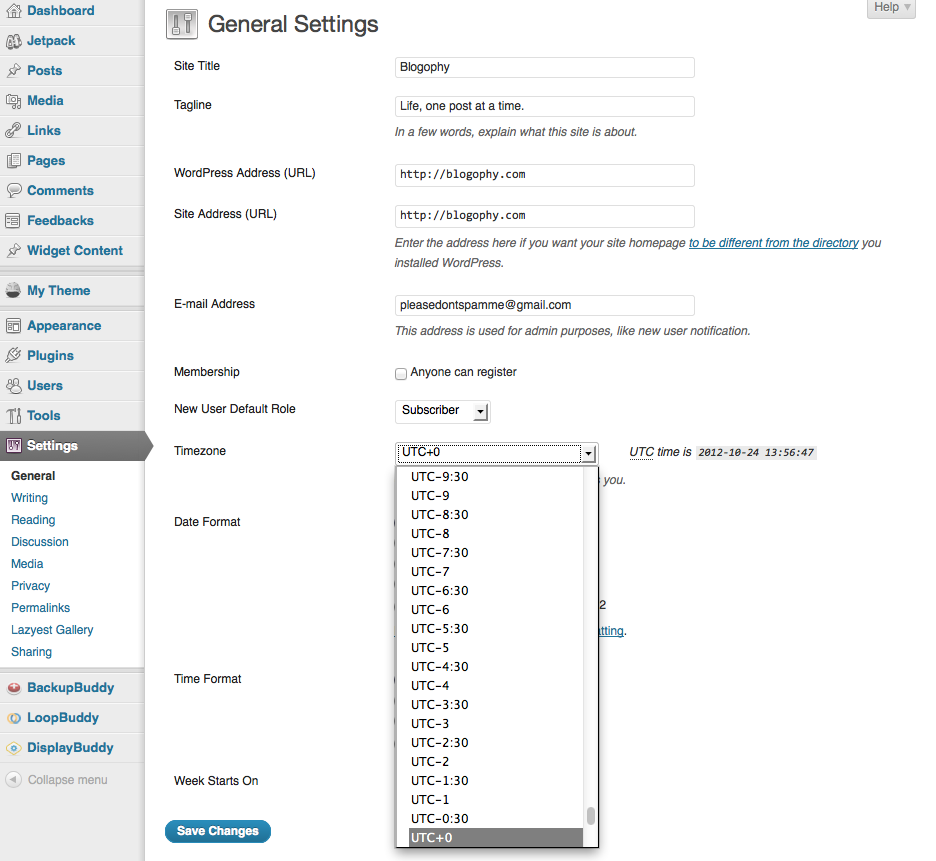The Top 10 WordPress Settings You Might Have Forgotten
Once you get WordPress installed, it can be easy to overlook your WordPress Settings. They can seem boring compared to adding themes or plugins and making tweaks to your new site, but they can definitely make a big difference in saving you time (and even some headaches) in the longrun. Before you move forward with a fresh install of WordPress, use this checklist of the top 10 WordPress Settings to remember.

Once you get WordPress installed, it can be easy to overlook your WordPress Settings. They can seem boring compared to adding themes or plugins and making tweaks to your new site, but they can definitely make a big difference in saving you time (and even some headaches) in the longrun.
Before you move forward with a fresh install of WordPress, use this checklist of the top 10 WordPress Settings to remember. This info is also great for auditing your current WordPress settings in existing WordPress sites, too.


 Note that the default WordPress category is “Uncategorized.” To add a more professional look to your site, create a new default category by visiting Posts > Categories from the WordPres dashboard. From there, add a new category like “General” or “Main” or “Sample” and then assign this new category as your default post category.
Note that the default WordPress category is “Uncategorized.” To add a more professional look to your site, create a new default category by visiting Posts > Categories from the WordPres dashboard. From there, add a new category like “General” or “Main” or “Sample” and then assign this new category as your default post category.
 If you use the iPhone or Android WordPress app for remote publishing to your blog, you’ll want to enable XML-RPC. This WordPress Setting must be enabled for outside applications to publish to your website.
If you use the iPhone or Android WordPress app for remote publishing to your blog, you’ll want to enable XML-RPC. This WordPress Setting must be enabled for outside applications to publish to your website.

 Adding Posts to the Menues page will allow you to add specific posts to custom menus.
Adding CSS Classes will create a new field beneath menu items. Use this field to assign a special CSS class for that specific menu item and utilize that class when styling that specific area in your stylesheet.
Adding Posts to the Menues page will allow you to add specific posts to custom menus.
Adding CSS Classes will create a new field beneath menu items. Use this field to assign a special CSS class for that specific menu item and utilize that class when styling that specific area in your stylesheet.
 All publishing users should complete their profile for Google Authorship and SEO purposes. Complete profile info by adding first and last name, website and biography information.
All publishing users should complete their profile for Google Authorship and SEO purposes. Complete profile info by adding first and last name, website and biography information.
 Adding the Slug to the Add New Posts page allows you to customize the actual URL for the post. For SEO purposes, you can get get rid of smaller words like “a” or “the” in the post title, which according to our permalink settings, is used as the default URL of the post.
Adding the Excerpt to the Add New Posts page allows you to utilize posts excerpts for different versions of the same post.
Adding the Slug to the Add New Posts page allows you to customize the actual URL for the post. For SEO purposes, you can get get rid of smaller words like “a” or “the” in the post title, which according to our permalink settings, is used as the default URL of the post.
Adding the Excerpt to the Add New Posts page allows you to utilize posts excerpts for different versions of the same post.
 If you’re developing a site, you usually want to keep it hidden until it’s finished. If you change your privacy settings to “ask search engines not to index this site” in the midst of development, don’t forget to change this setting back after your site has launched!
If you’re developing a site, you usually want to keep it hidden until it’s finished. If you change your privacy settings to “ask search engines not to index this site” in the midst of development, don’t forget to change this setting back after your site has launched!
1. Permalinks
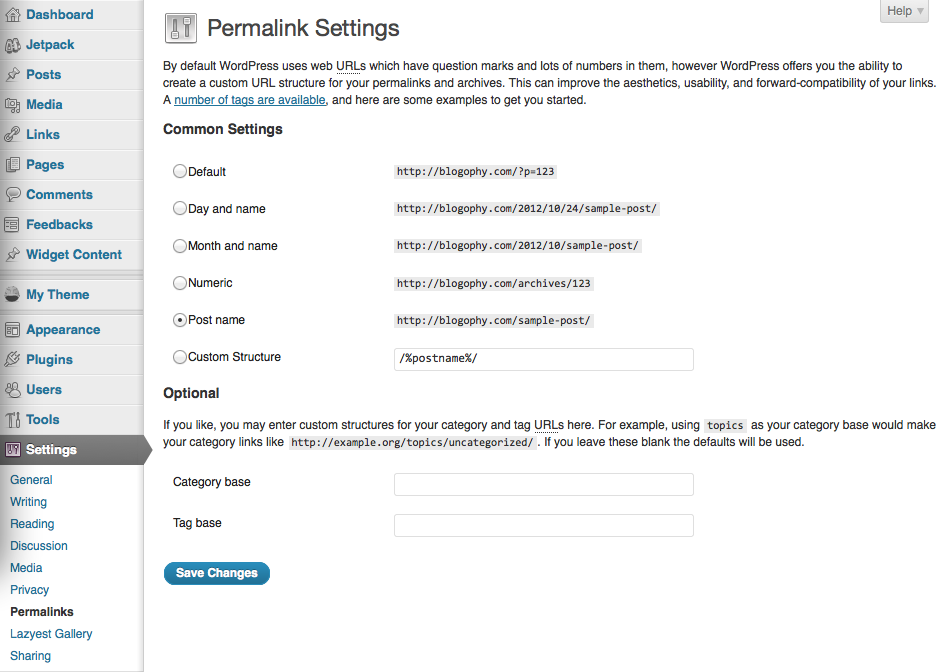
From the WordPress dashboard, visit Settings > Permalinks. Our recommendation? Choose “Post name.”
Permalinks are the #1 setting people forget to update. By default, WordPress uses web URLs that include question marks and lots of numbers in them, but WordPress offers you the ability to choose (or create) a custom URL structure for your permalinks and archives. Changing this default setting for permalinks can improve the aesthetics, usability and forward-compatibility of your links.2. Tagline
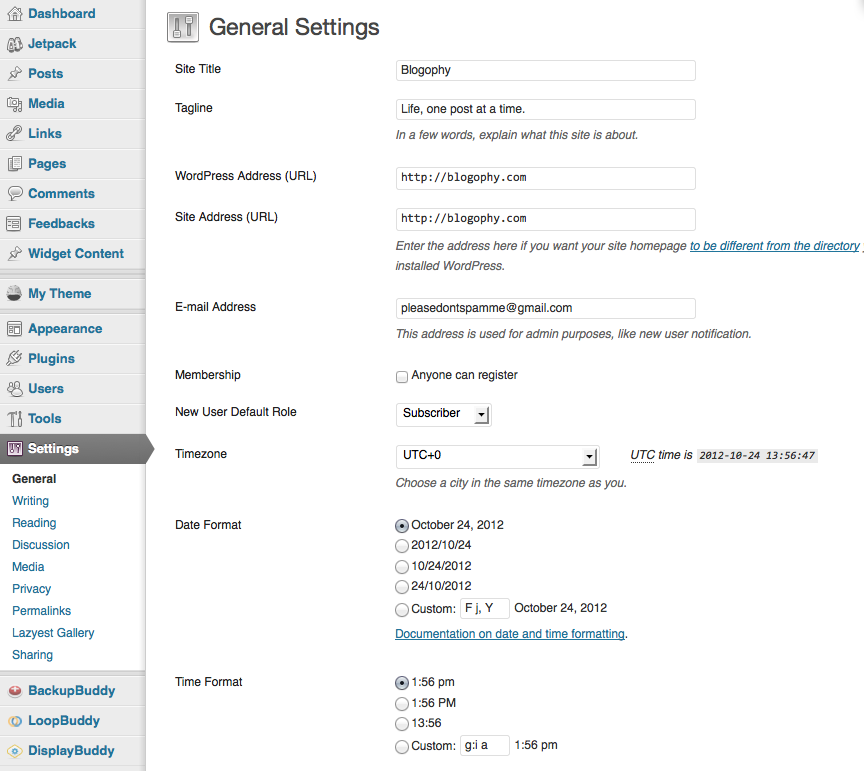
From the WordPress dashboard, visit Settings > General.
Since some themes don’t utilize your site’s tagline in the header, it can be easy to forget about it. Don’t leave the default tagline “just another WordPress site” because WordPress still utilizes it. You’ll want to make sure this is updated to reflect your site and content. To see why, just Google “just another WordPress site.” You’ll be surprised how this tagline can still show up beside a site title in your search results.3. Timezone
From the WordPress dashboard, visit Settings > General.
Below the site tagline on the General Settings page, make sure to update your timezone. Why is this important? Dates and times are usually visible on published posts, so don’t put yourself in a time warp.4. Default Post Category
From the WordPress dashboard, visit Settings > Writing.
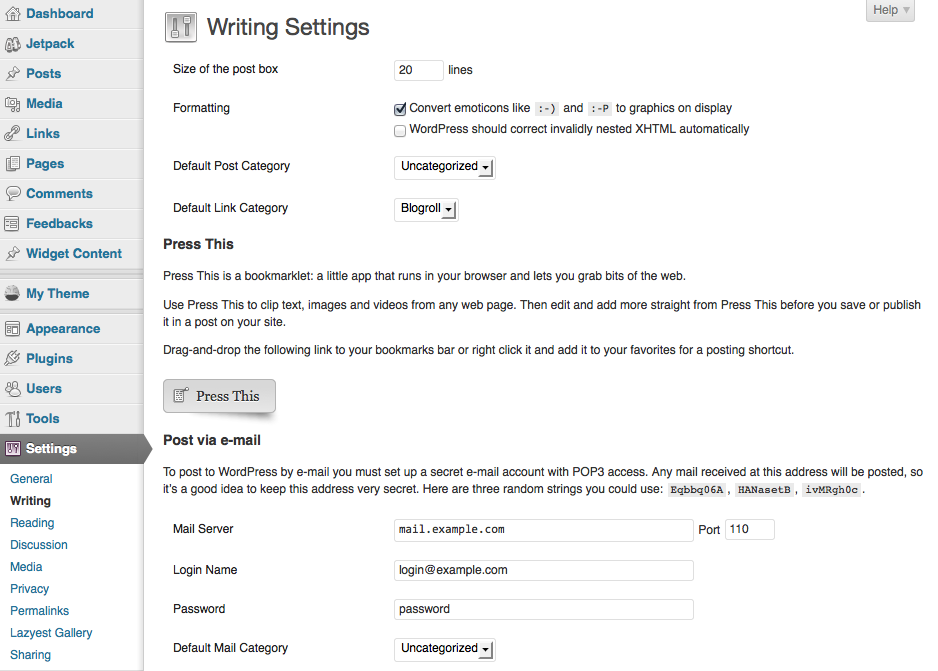 Note that the default WordPress category is “Uncategorized.” To add a more professional look to your site, create a new default category by visiting Posts > Categories from the WordPres dashboard. From there, add a new category like “General” or “Main” or “Sample” and then assign this new category as your default post category.
Note that the default WordPress category is “Uncategorized.” To add a more professional look to your site, create a new default category by visiting Posts > Categories from the WordPres dashboard. From there, add a new category like “General” or “Main” or “Sample” and then assign this new category as your default post category.
5. Enable XML-RPC
From the WordPress dashboard, visit Settings > Writing.
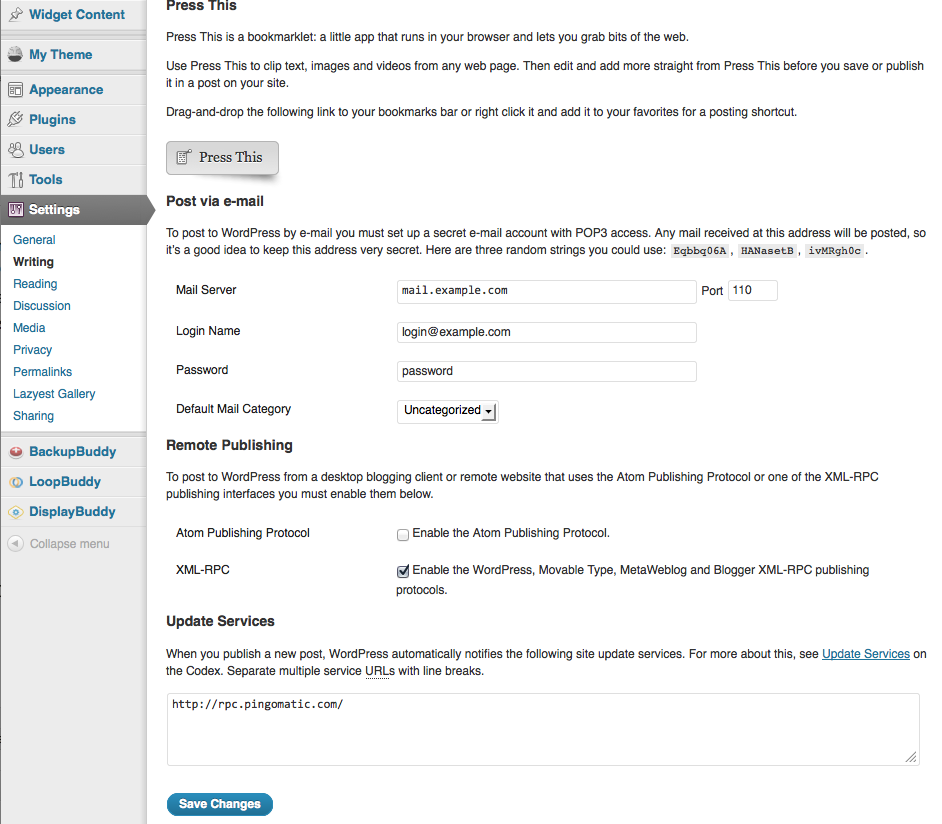 If you use the iPhone or Android WordPress app for remote publishing to your blog, you’ll want to enable XML-RPC. This WordPress Setting must be enabled for outside applications to publish to your website.
If you use the iPhone or Android WordPress app for remote publishing to your blog, you’ll want to enable XML-RPC. This WordPress Setting must be enabled for outside applications to publish to your website.
6. Menus
From the WordPress dashboard, visit Appearance > Menus.

Create a custom menu.
Although WordPress menus aren’t technically a WordPress Setting, creating a custom menu before you start building your site will save you time. You won’t have to stop developing your site to add a menu to be able to utilize or assign it in Builder’s Navigation Module. Create a custom menu like “Primary” or “Main” to get started.Add Posts and CSS Classes from Menus Screen Options.
At the top of the Menus Page, click Screen Options and make sure “Posts” and “CSS Classes” are checked.
 Adding Posts to the Menues page will allow you to add specific posts to custom menus.
Adding CSS Classes will create a new field beneath menu items. Use this field to assign a special CSS class for that specific menu item and utilize that class when styling that specific area in your stylesheet.
Adding Posts to the Menues page will allow you to add specific posts to custom menus.
Adding CSS Classes will create a new field beneath menu items. Use this field to assign a special CSS class for that specific menu item and utilize that class when styling that specific area in your stylesheet.
7. User Profile
From the WordPress dashboard, visit Users > Your Profile
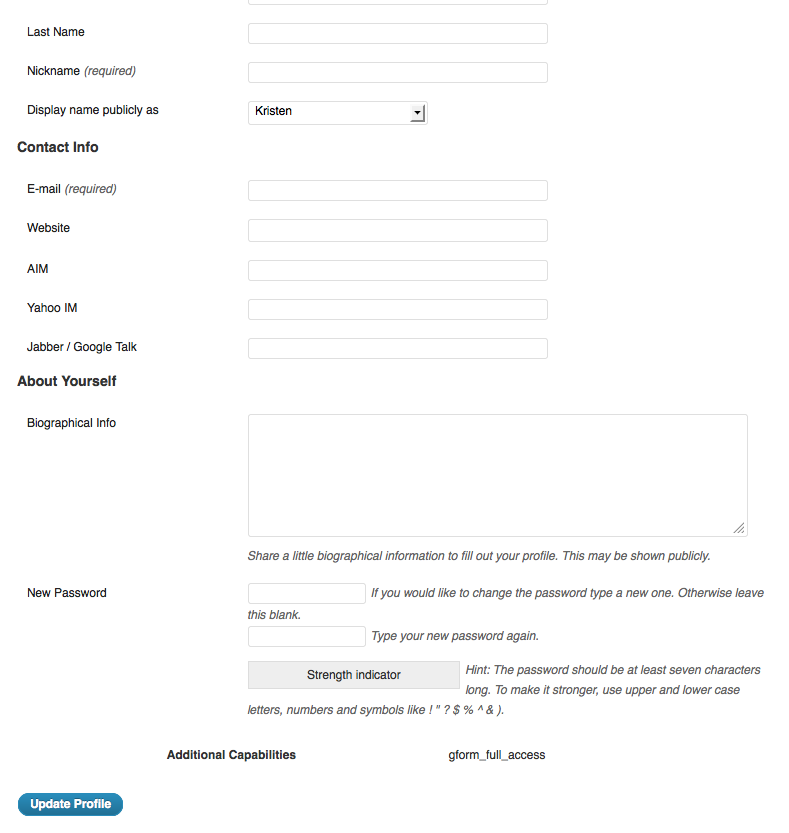 All publishing users should complete their profile for Google Authorship and SEO purposes. Complete profile info by adding first and last name, website and biography information.
All publishing users should complete their profile for Google Authorship and SEO purposes. Complete profile info by adding first and last name, website and biography information.
8. Post Slug and Excerpt
From the WordPress dashboard, visit Posts > Add New. Click Screen Options and make sure “Slug ” and “Excerpt” are checked.
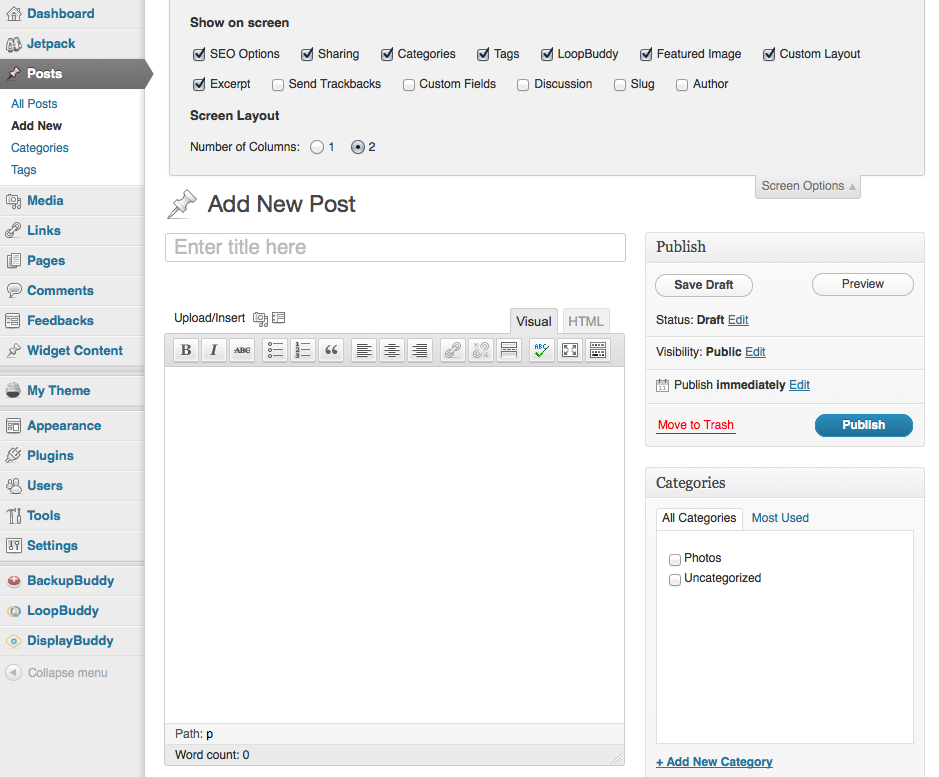 Adding the Slug to the Add New Posts page allows you to customize the actual URL for the post. For SEO purposes, you can get get rid of smaller words like “a” or “the” in the post title, which according to our permalink settings, is used as the default URL of the post.
Adding the Excerpt to the Add New Posts page allows you to utilize posts excerpts for different versions of the same post.
Adding the Slug to the Add New Posts page allows you to customize the actual URL for the post. For SEO purposes, you can get get rid of smaller words like “a” or “the” in the post title, which according to our permalink settings, is used as the default URL of the post.
Adding the Excerpt to the Add New Posts page allows you to utilize posts excerpts for different versions of the same post.
9. Page Slug
From the WordPress dashboard, visit Pages > Add New. Click Screen Options and make sure “Slug “ is checked.
Again, adding the slug to the Add New Posts page allows you to customize the URL for the page for SEO purposes.10. Privacy
From the WordPress dashboard, visit Settings > Privacy. Check your settings.
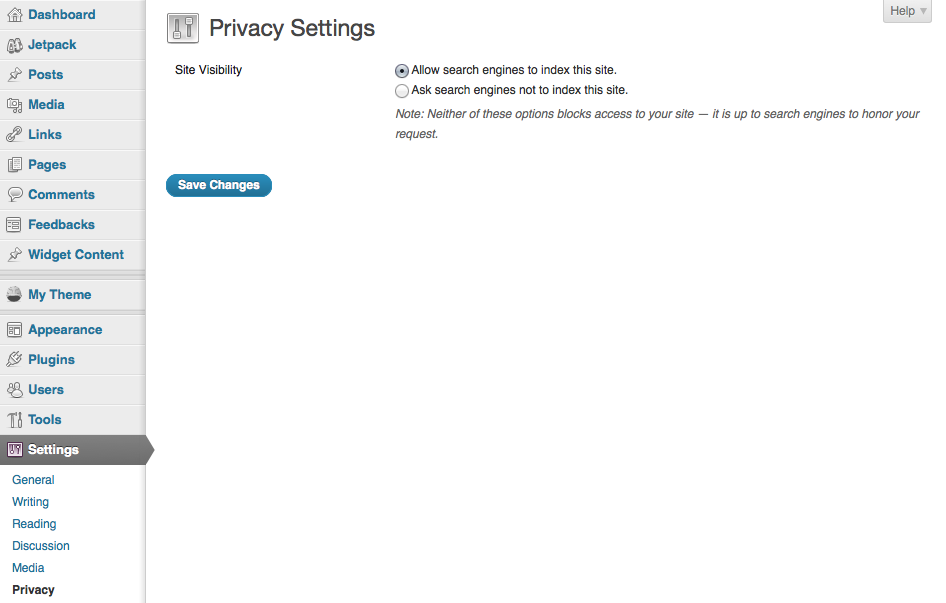 If you’re developing a site, you usually want to keep it hidden until it’s finished. If you change your privacy settings to “ask search engines not to index this site” in the midst of development, don’t forget to change this setting back after your site has launched!
If you’re developing a site, you usually want to keep it hidden until it’s finished. If you change your privacy settings to “ask search engines not to index this site” in the midst of development, don’t forget to change this setting back after your site has launched!
With the rollout of the all-new iThemesTV format, we’ll be sharing great WordPress tips like these each Tuesday @ 11am CDT. Tune in again next week on iThemesTV with your host Benjamin Bradley (the “Professor” at WebDesign.com) for more WordPress tips and tricks, plus sneak peeks at new iThemes products from the iThemes Dev Team.
Check out the entire video from yesterday’s iThemesTV below where we share these “Top 10 Settings” and also preview BackupBuddy Stash, our new remote storage destination – due out very soon: http://www.youtube.com/watch?v=nMmvct4fDS0Sign up now — Get SolidWP updates and valuable content straight to your inbox
Sign up
Placeholder text
Placeholder text
Get started with confidence — risk free, guaranteed
